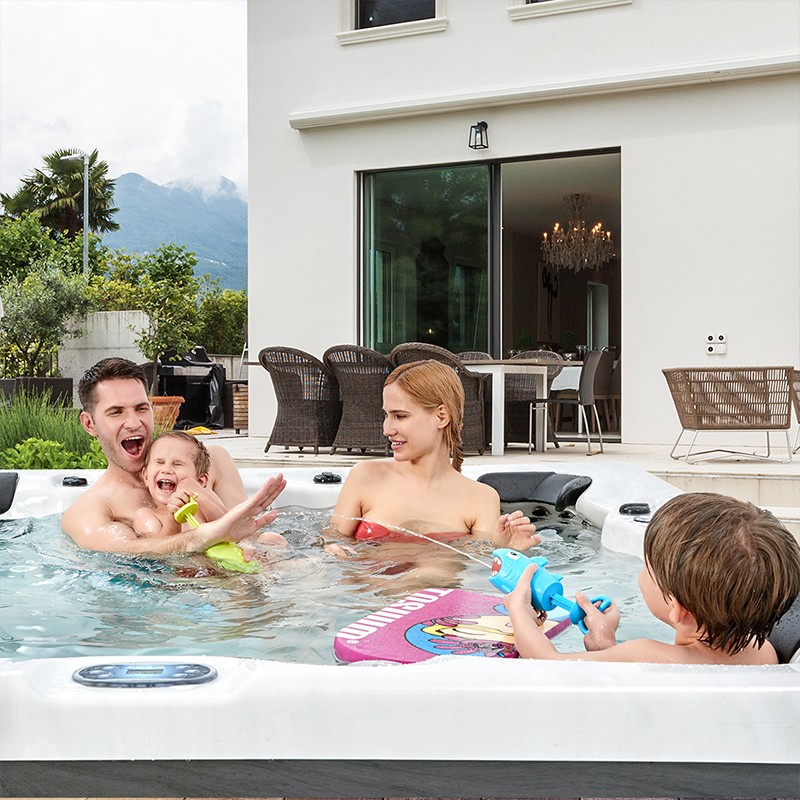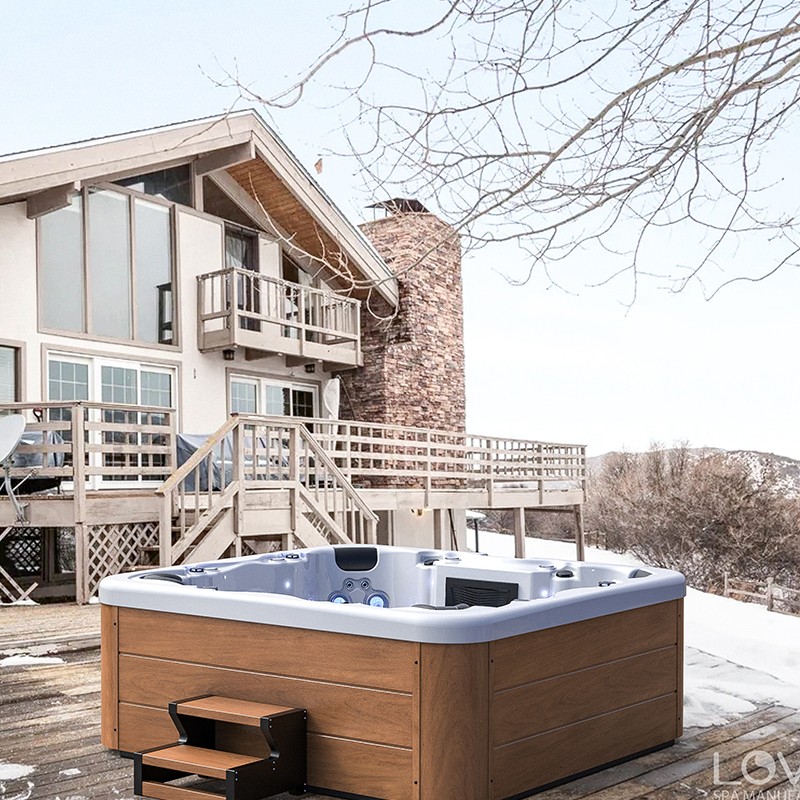
Can viruses survive in a whirlpool spa hot tub?
2025-11-25 15:30Whirlpool spa hot tubs are comfortable facilities that combine relaxation, therapy, and social interaction, making them popular with families and health enthusiasts. However, many people have a common question while enjoying a warm bath: can viruses survive in a whirlpool spa hot tub?
This is an important question concerning health and hygiene. To answer this question, it is necessary to understand the survival conditions of viruses, the water quality environment of the whirlpool spa hot tub, the disinfection mechanism, and proper maintenance.
This article will provide a detailed analysis of the possibility of virus survival in a whirlpool spa hot tub from a scientific perspective, and offer scientifically sound protection and cleaning recommendations.

How long can viruses survive in a whirlpool spa hot tub?
Whether viruses can survive in a whirlpool spa hot tub mainly depends on three core factors: water temperature, chemical disinfectant concentration, and the efficiency of the water circulation and filtration system.
1. The Impact of Water Temperature on Virus Survival
Most whirlpool spa hot tubs maintain a temperature of around 37°C to 40°C. While this temperature range is ideal for human muscle relaxation, it presents an unfavorable environment for viruses.
Many common viruses (such as influenza viruses, coronaviruses, and enteroviruses) are rapidly inactivated in high-temperature environments. Typically, after several minutes of continuous exposure to 40°C hot water, the activity of most viruses will significantly decrease.
In other words, the high temperature environment of a whirlpool spa hot tub itself can inhibit viral survival to some extent.
2. The Role of Disinfectants
In addition to temperature, disinfectants such as chlorine or bromine are usually added to whirlpool spa hot tubs. These chemicals effectively destroy the outer membrane or protein structure of viruses, thereby rendering them infective.
As long as the concentration of disinfectants remains within recommended standards (e.g., chlorine concentration of 3-5 ppm, bromine concentration of 4-6 ppm), viruses have almost no room to survive in such water.
3. Impact of Water Flow and Filtration System
The whirlpool spa hot tub's circulation system continuously propels water through filters and auxiliary disinfection devices such as ozone and ultraviolet light. This continuous water circulation significantly reduces the possibility of microbial aggregation, making it difficult for viruses to survive for extended periods even if they briefly enter the water.
In summary, viruses can hardly survive long-term in a well-maintained and properly disinfected whirlpool spa hot tub.

But what if disinfection is inadequate? Can viruses spread in a whirlpool spa hot tub?
This is a crucial question. While viruses are unlikely to survive under ideal conditions, improper maintenance of the whirlpool spa hot tub can indeed make it a medium for the transmission of viruses and bacteria.
1. Risk of Insufficient Disinfectant Concentration
When the chlorine or bromine concentration in the whirlpool spa hot tub is insufficient, the water loses its ability to kill viruses. Especially with frequent use by multiple people, skin secretions, cosmetic residue, sweat, and urine consume disinfectant, causing the effective concentration in the water to drop rapidly.
At this time, if a user carries virus particles into the water, there is a risk of indirect contact with others.
2. Residue Issues in Filter Cartridges and Pipes
The filtration system is a crucial part of whirlpool spa hot tub hygiene management. If the filter cartridge is not cleaned or replaced regularly, the accumulated organic matter inside can become a haven for viruses and bacteria.
Simultaneously, stagnant water areas inside the pipes, if not flushed regularly, can easily breed biofilms. These biofilms protect microorganisms from disinfectant damage, indirectly increasing the risk.
3. Environmental Cross-Contamination
Even if the water itself is well disinfected, there is still a risk of contact transmission if areas such as the bathtub rim, lid, and handrails are not cleaned regularly. Viruses can survive for short periods on damp surfaces, making thorough cleaning of every part of the whirlpool spa hot tub essential.
Which viruses could theoretically exist in a whirlpool spa hot tub?
While most viruses are difficult to survive in hot water and chemical environments, a temporary risk may still exist under extreme conditions.
1. Skin Contact Viruses
For example, herpes simplex virus (HSV) or human papillomavirus (HPV) can theoretically be transmitted through skin contact. However, these viruses primarily attach to the skin surface, rather than spreading through water. Therefore, the possibility of transmission in a hot, chlorinated whirlpool spa hot tub is extremely low.
2. Enteroviruses
Some enteroviruses (such as norovirus) can survive for a longer period in cold water, but are rapidly inactivated in hot and disinfected environments. They may only survive briefly when the temperature of the whirlpool spa hot tub is low and the chlorine concentration is insufficient.
3. Respiratory Viruses
Viruses like influenza or coronaviruses, which are transmitted through droplets, are almost impossible to transmit through water because their outer membrane structure is easily destroyed by chlorine or bromine.
In short, a whirlpool spa hot tub is not an ideal environment for viruses. The vast majority of viruses cannot survive for more than a few minutes in such a hot, highly disinfected environment.

How to ensure that a whirlpool spa hot tub does not become a breeding ground for viruses?
To ensure safe and hygienic use, continuous maintenance and scientific management are key.
1. Maintain a stable disinfectant concentration
Whether using chlorine or bromine, it is essential to ensure that the concentration is maintained within the recommended range. Users are advised to test water quality at least 2-3 times per week and replenish disinfectant as needed based on usage frequency.
In addition, ozone disinfection or ultraviolet (UV) systems can be used to further enhance the water's sterilization capabilities.
2. Clean the filter regularly
The filter of the Whirlpool spa hot tub should be removed and cleaned every two weeks and completely replaced every three months. If used frequently, the interval should be shortened.
Use professional filter cleaning solutions instead of household cleaners to avoid secondary pollution of the water by chemical residues.
3. Change the water every three months
No matter how thorough the daily maintenance, the organic load in the water will gradually accumulate, reducing the efficiency of disinfectants. Regularly draining, cleaning, and refilling the water is a key step in maintaining hygiene.
4. Clean the bathtub surface and lid
After each use, wipe the edges and lid dry with a clean towel. Regularly clean the surfaces with a mild, neutral detergent to prevent microbial growth.
5. Ensure good water circulation
Run the filtration system for at least 4-6 hours daily to ensure water flow covers every corner of the bathtub and prevent stagnant water zones.
Personal Protective Measures for Whirlpool Spa Hot Tub Users
Besides equipment maintenance, user hygiene habits are equally important.
• Shower before bathing to reduce the amount of body oils, skincare products, and sweat entering the water;
• Avoid using the tub when you have a cold or skin wounds to prevent the spread of bacteria and viruses;
• Cleanse yourself promptly after use to remove residual disinfectant and impurities from the water;
• Avoid multiple people bathing together for extended periods to reduce the risk of cross-contamination;
• Regularly test the water pH level (maintaining it between 7.2 and 7.8) to ensure optimal disinfection effectiveness.

Is the Whirlpool Spa Hot Tub Safe?
Under proper maintenance, viruses cannot survive long-term in a Whirlpool Spa Hot Tub.
High temperatures, the bactericidal effects of chlorine or bromine, water circulation, and the filtration system combine to create an environment extremely unfavorable to viruses.
The real risk comes from neglecting daily maintenance, insufficient disinfection, or an aging filter. As long as you regularly test the water quality, clean the equipment, and maintain the correct chemical balance, you can safely and confidently enjoy the soothing and relaxing experience of a Whirlpool Spa Hot Tub.
How Long Has LOVIA SPA Been in Business?
LOVIA SPA has been manufacturing spas and swim spas since 1989. With over three decades of experience, we have grown into one of China’s leading spa manufacturers. Buyers trust our factory for consistent quality, professional service, and fair prices. Over the years, our brand has expanded into Europe, North America, and Asia.
Choosing LOVIA SPA means working with a reliable company that understands global markets, offers customized products, and provides continuous wholesale supply and after-sales service.
